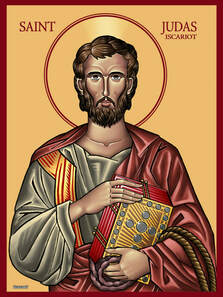Easter Sunday, April 21, 2019
First Congregational Church of Cheshire
© the Rev. Dr. James Campbell
John 20:1-18
Early on the first day of the week, while it was still dark, Mary Magdalene came to the tomb and saw that the stone had been removed from the tomb. So she ran and went to Simon Peter and the other disciple, the one whom Jesus loved, and said to them, “They have taken the Lord out of the tomb, and we do not know where they have laid him.” Then Peter and the other disciple set out and went toward the tomb. The two were running together, but the other disciple outran Peter and reached the tomb first. He bent down to look in and saw the linen wrappings lying there, but he did not go in. Then Simon Peter came, following him, and went into the tomb. He saw the linen wrappings lying there, and the cloth that had been on Jesus’ head, not lying with the linen wrappings but rolled up in a place by itself. Then the other disciple, who reached the tomb first, also went in, and he saw and believed; for as yet they did not understand the scripture, that he must rise from the dead. Then the disciples returned to their homes.
But Mary stood weeping outside the tomb. As she wept, she bent over to look into the tomb; and she saw two angels in white, sitting where the body of Jesus had been lying, one at the head and the other at the feet. They said to her, “Woman, why are you weeping?” She said to them, “They have taken away my Lord, and I do not know where they have laid him.” When she had said this, she turned around and saw Jesus standing there, but she did not know that it was Jesus. Jesus said to her, “Woman, why are you weeping? Whom are you looking for?” Supposing him to be the gardener, she said to him, “Sir, if you have carried him away, tell me where you have laid him, and I will take him away.” Jesus said to her, “Mary!” She turned and said to him in Hebrew, “Rabbouni!” (which means Teacher). Jesus said to her, “Do not hold on to me, because I have not yet ascended to the Father. But go to my brothers and say to them, ‘I am ascending to my Father and your Father, to my God and your God.’” Mary Magdalene went and announced to the disciples, “I have seen the Lord”; and she told them that he had said these things to her.
+++
I’ve been trying to grab hold of Jesus for as long as I can remember. As a young teenager, I had this incredible oversized 3-D postcard of the Shroud of Turin. The thing was awesome. If you held it to the light one way, you saw an artist’s rendering of the face of Jesus, inspired by a photographic negative of the Shroud. Held one way, it was a death mask, eyes closed. But if you moved the postcard the other way, the eyes of Jesus would open. There he was, alive. I would spend hours flipping back and forth and watching those eyes open and close. And I used to wonder: “What if I am looking at the very face of Jesus the moment he was resurrected?”
Believers in the Shroud’s authenticity maintain that this image of the broken body of the Lord was not made by traditional artistic methods. Instead, they say, it was burned onto the cloth at the very moment of Resurrection, by a sort of radiation, a side effect – if you will - of all that life-giving glory. In the shroud, they say, we have physical proof for this most foundational of all Christian beliefs – that Jesus of Nazareth, crucified by Rome, dead and buried, was raised to new and everlasting life by the power of God.
The shroud is some people’s way to try to grab hold of Jesus. They need the Shroud to be authentic because that would make it an actual witness to the Resurrection – something no human could ever say. All four Gospels agree on that. No one was in the tomb when it happened. There were no eye witnesses to this event. Theologian Barbara Brown Taylor writes: “Whatever happened in (that) cave happened in the dark. …it happened in complete silence, in absolute darkness, with the smell of damp stone and dug earth in the air.”[1]
So no one saw the actual moment. But lots of folks claimed to have seen the aftereffect. Ordinary people, like you and me, at different times and in different places claimed to have had encounters with the strangely elusive figure of the Risen Jesus, who appeared and disappeared at a moment’s notice. We don’t know exactly what it was they experienced, but whatever it was, it was enough to change their lives forever. Whatever it was, it started a world-wide movement that has become the world’s largest religion. Whatever it was, it was enough that 2000 years later, here we are, in this room, to celebrate it.
Very early on Sunday morning, while it was still dark; while it was dangerous for a woman to be traveling unaccompanied, a grief-stricken Mary Magdalene went to the grave of Jesus anyway. And when she arrived, she noted with fear that the stone had been rolled away from the mouth of the tomb. And so she ran to tell Peter and another unnamed disciple that someone had stolen the body of Jesus, which was the most logical conclusion. Upon hearing this distressing news, the three ran back to the graveyard; each one looking inside the tomb, each one seeing no corpse. Instead, the grave clothes were neatly folded on the slab; the face cloth carefully rolled up, something grave robbers would not have taken the time to do. So that was perplexing. But the notion of Resurrection never crossed their minds.
The two men being men decided that they needed to do something – anything - about this! So, they ran off to tell the others. They ran off… and left Mary by herself, still unaccompanied, grief-stricken, in the dark.
Suddenly, from the shadows, a stranger appeared. Startled, Mary assumed that he was the gardener and asked if he knew where the body of Jesus had been moved. “Please tell me,” she begged, “so that I can go and take the body myself.” As if she could. But grief does strange things to the mind. And still there was no thought of Resurrection.
The gardener did not answer her question. But he did speak. He spoke her name. And when he did, it was like a flash of lightening. For just a moment, everything was as clear as midday. “Rabbouni; my teacher” she cried and grabbed hold of him, hanging on for dear life. Now that she had him back, she would never let him go. But then Jesus made an odd statement: “Do not hold on to me, because I have not yet ascended to the Father.” “Do not hold onto me…” “Do not hold onto me…”And in that odd statement, an essential truth about the Resurrection is revealed. It cannot, in any tangible way, be grasped. Resurrection cannot be codified or put in a box or explained in a theology book or proven in a debate. Resurrection can only be experienced. And it usually comes to us as a flash of something too good to be true.
So, was it real? Was it a dream? Was it the hallucination of a sleep-deprived, grief-stricken woman? Whatever happened to Mary Magdalene in that garden was enough to convince her to believe the impossible. And so she ran back to where the men were now hiding in fear for their lives and Mary Magdalene, a woman, preached the first Easter sermon ever, boldly announcing to anyone who would listen: “I have seen the Lord.”
If only she’d had her iPhone with her! If only Jesus had whispered the secret word in her ear that only he would know. If only he had given her something to prove that she wasn’t crazy. But all she had was her experience. All she had was that flash of the Resurrection. And that is all that anyone has ever had.
Flashes of the Resurrection - maybe that’s what you came to church seeking today. That’s what the great 20thcentury Swiss theologian Karl Barth said. Barth said that the reason people come to church on Easter or on any Sunday is the unspoken question clinging to our hearts and minds “Is it true?”
In her marvelous short story entitled “See the Other Side” author Tatyana Tolstaya writes beautifully about our human struggle to dare to believe what we hope is true, but cannot prove. She writes: “We hear whispers, but we plug our ears; we are shown, but we turn away. We have no faith: we’re afraid to believe, because we’re afraid that we’ll be deceived. We are certain that we’re in the tomb. We are certain that there’s nothing in the dark. There can’t be anything in the dark.”[2]
Except that the message of Easter is that the Risen Christ dwells in those shadows and in that darkness. What proof do I have of that? Only my own experience. For you see, there have been moments in my own life when I have been so low. Like you, I have buried those I love. Like you, my health has faltered. Like you, my relationships have crumbled. Like you, I have lost my job. Like you, I have sometimes wondered – truly - if God exists and if I’m wasting my life doing what I do. And like you, I have doubted this incredible nonsense about a dead man being raised to life. But… time after time after time, at the edge of despair, in the darkness of doubt, in the midst of grief, I have been surprised by a Presence that knows my name. It’s always just a flash - but it’s enough for me to actually believe that I too have seen the Lord.
Thanks be to God. Amen.
[1]Learning to Walk in the Dark, Barbara Brown Taylor
[2]The New Yorker, March 12, 2007


 RSS Feed
RSS Feed